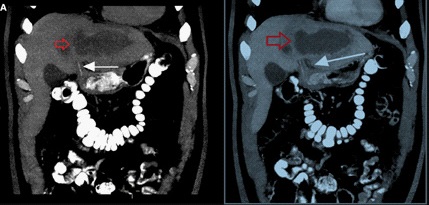
Journal of Clinical Images and Medical Case Reports
ISSN 2766-7820
Clinical Image - Open Access, Volume 3
A toothpick’s tale
Ana Duarte Mendes*; Renata Ribeiro; Marta Amaral
1 Oncology Department Hospital Fernando da Fonseca, Amadora, Portugal.
2 Internal Medicine Department, Hospital Prof. Dr. Fernando da Fonseca, Amadora, Portugal.
*Corresponding Author: Ana Duarte Mendes
Oncology Department, Hospital Fernando da Fonseca, Amadora, Portugal.
Email: ana.duarte.mendes@gmail.com
Received : Feb 23, 2022
Accepted : Apr 15, 2022
Published : Apr 22, 2022
Archived : www.jcimcr.org
Copyright : © Mendes AD (2022).
Citation: Mendes AD, Ribeiro R, Amaral M. A toothpick’s tale. J Clin Images Med Case Rep. 2022; 3(4): 1804.
Clinical image description
A 68-year-old man presented to the emergency department with a 2-week history of fever, shivering and general malaise. Physical examination was otherwise unremarkable. Laboratory findings showed elevation of C-reactive protein (33 mg/dL), aspartate and alanine aminotransferase (89 and 120 U/L, respectively). A computed tomographic scan showed a large mass on the left hepatic lobe compatible with an abscess (Panels A, red arrow). Further viewing of the images confirmed the perforation of the digestive tract by a foreign body (Panels A, white arrow) and its migration through the gastroduodenal wall. These findings were confirmed by laparoscopy with the extraction of a toothpick (Panel B) and drainage of the abscess. Fever resolved and the patient was asymptomatic at discharge. Pyogenic liver abscess constitutes an infrequent clinical condition presenting a diagnostic challenge to physicians. Ingestion of a foreign body represents an even more rare cause of this clinical entity.


